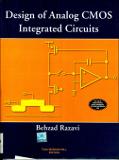| dc.description.abstract | In the past two decades, CMOS technology has rapidly embraced the field of analog integrated circuits, providing low-cost, high-performance solutions and rising to dominate the market. While silicon bipolar and Ill-V devices still find niche applications, only CMOS processes have emerged as a viable choice for the integration of today's complex mixed-signal systems. With channel lengths projected to scale down to 0.03 Am, CMOS technology will continue to serve circuit design for probably another two decades.
Analog circuit design itself has evolved with the technology as well. High-voltage, high-power analog circuits containing a few tens of transistors and processing small, continuous- time signals have gradually been replaced by low-voltage, low-power systems comprising thousands of devices and processing large, mostly discrete-time signals. For example, many analog techniques used only ten years ago have been abandoned because they do not lend themselves to low-voltage operation.
This book deals with the analysis and design of analog CMOS integrated circuits, emphasizing fundamentals as well as new paradigms that students and practicing engineers need to master in today's industry. Since analog design requires both intuition and rigor, each concept is first introduced from an intuitive perspective and subsequently treated by careful analysis. The objective is to develop both a solid foundation and methods of analyzing circuits by inspection so that the reader learns what approximations can be made in which circuits and how much error to expect in each approximation. This approach also enables the reader to apply the concepts to bipolar circuits with little additional effort.
I have taught most of the material in this book both at UCLA and in industry, polishing the order, the format, and the content with every offering. As the reader will see throughout the book, I follow four "golden rules" in writing (and teaching): (1)1 explain why the reader needs to know the concept that is to be studied; (2) I put myself in the reader's position and predict the questions that he/she may have while reading the material for the first time; (3) With Rule 2 in mind, I pretend to know only as much as the (first-time) reader and try to "grow" with him/her, thereby experiencing the same through process; (4) I begin with the "core" concept in a simple (even imprecise) language and gradually add necessary modifications to arrive at the final (precise) idea. The last rule is particularly important in teaching circuits because it allows the reader to observe the evolution of a topology and hence learn both analysis and synthesis.
The text comprises 18 chapters whose contents and order are carefully chosen to provide a natural flow for both self-study and classroom adoption in quarter or semester systems. Unlike some other books on analog design, we cover only a bare minimum of MOS device physics at the beginning, leaving more advanced properties and fabrication details for later chapters. To an expert, the elementary device physics treatment may appear oversimplified, but my experience suggests that (a) first-time readers simply do not absorb the high-order device effects and fabrication technology before they study-circuits because they do not see the relevance; (b) if properly presented, even the simple treatment proves adequate for a substantial coverage of basic circuits; (c) readers learn advanced device phenomena and processing steps much more readily after they have been exposed to a significant amount of circuit analysis and design.
Chapter 1 provides the reader with motivation for learning the material in this book.
Chapter 2 describes basic physics and operation of MOS devices.
Chapters 3 through 5 deal with single-stage and differential amplifiers and current mirrors, respectively, developing efficient analytical tools for quantifying the behavior of basic circuits by inspection.
Chapters 6 and 7 introduce two imperfections of circuits, namely, frequency response and noise. Noise is treated at an early stage so that it "sinks in" as the reader accounts for its effects in subsequent circuit developments.
Chapters 8 through 10 describe feedback, operational amplifiers, and stability in feedback systems, respectively. With the useful properties of feedback analyzed, the reader is motivated to design high-performance, stable op amps and understand the trade-offs between speed, precision, and power dissipation.
Chapters 11 through 13 deal with more advanced topics: bandgap references, elementary switched-capacitor circuits, and the effect of nonlinearity and mismatch. These three subjects are included here because they prove essential in most analog and mixed-signal systems today.
Chapters 14 and 15 concentrate on the design of oscillators and phase-locked loops, respectively. In view of the wide usage of these circuits, a detailed study of their behavior and many examples of their operation are provided.
Chapter 16 is concerned with high-order MOS device effects and models, emphasizing the circuit design implications. If preferred, this chapter can directly follow Chapter 2 as well. Chapter 17 describes CMOS fabrication technology with a brief overview of layout design rules.
Chapter 18 presents the layout and packaging of analog and mixed-signal circuits. Many practical issues that directly impact the performance of the Circuit are described and various techniques are introduced.
The reader is assumed to have a basic knowledge of electronic circuits and devices, e.g., pn junctions, the concept of small-signal operation, equivalent circuits, and simple biasing. For a senior-level elective course, Chapters 1 through 8 can be covered in a quarter and Chapters 1 through 10 in a semester. For a first-year graduate course, Chapters 1 through 11 plus one of Chapters 12 through 15 can be taught in one quarter, and the first 16 chapters in one semester.
The problem sets at the end of each chapter are designed to extend the reader's understanding of the material and complement it with additional practical considerations. A solutions manual is available for instructors. | en_US |





